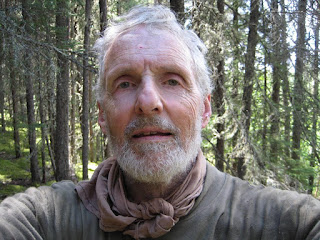The next two km was largely up a meandering "beaver creek", over at least 12 beaver dams including a one metre high dam that I had to portage. More poling, paddling, wading, pushing, pulling, lifting, lining, towing. Aie! At least the weather was cooperating.
Unfortunately I left my Emergency Belt Bag at the beaver dam. When I unloaded the canoe prior to pulling the canoe over the dam, I removed the bag and placed it on the ground with all my gear. Aie! I canoed one km across a lake at the upper end of the creek thinking I was ready to look for a portage to the next lake. On landing I immediately noticed the absence of the belt bag. Stupid, stupid, stupid! Not a good thing to do for an item that is meant to be available if I lose everything else. Aie! On the trip back to the dam I had to paddle against a strong wind. The one positive thing was that I saw a cow moose along the shore. She had entered the water and was eating some vegetation. I was able to paddle close enough to get some photos. On getting back to the end of the lake I spent about one hour in the bush searching for a portage in what I thought was the most likely location, but to no avail, even walking as far as the target lake. I decided to continue on up the next section of the creek. At another small lake I spent another hour in the bush searching for a portage. The only trails I found were those made by beavers hauling trees into the water.
Finally I decided to continue up the creek. I landed at the spot where the creek tumbles down a small falls. I cut a 50 metre portage trail to the upper side of the falls where I stopped to have a well-deserved lunch break. It felt good to dry out after getting sweat-soaked with all the tramping in the bush.
The next one km section of creek was the hardest yet, very narrow and winding, so that the canoe would get stuck. A 17 foot canoe does not fit in sharp narrow turns. More poling, paddling, wading, pushing, pulling, lifting, lining, towing. Aie! Up until now I had been able to stand on beaver dams and soft ground wearing my leather boots. The boots were getting wet up to the top of the foot portion and my feet were only damp. These new footwear were really getting tested and passed with flying colours. With a Vibram™ sole and Goretex™ liner they were keeping out water even when I was in water many hours a day; I was impressed. Now I had to put on my wading gear (nylon pants, neoprene socks, canvas shoes) as the creek became more difficult to navigate. However, I had to be careful, as although narrow, the creek was quite deep, sometimes well over my head. Aie! So now I was hopping from hummock to hummock in the cattails. Sometimes I despaired of getting the canoe through without unloading. Unloading would be a problem because there was no dry place to set the gear. Finally I reached the upper end of the creek and the target lake was in sight.
Another portage to cut, 130 metres long through a beautiful mossy section of bush.
Camp 11, a total of 12 km travelled, including three portages (10, 50, 130 metres), and three km of "beaver creek". This campsite overlooks a gorgeous lake.
A 25" pike and 18" walleye.
Many of my campsites were areas used by North American river otters, evidenced by scales of fish they ate and otter "playgrounds" where they tumble with each other and slide into the lake.
It was definitely time to do laundry. While the clothes dry, so too do my boots and the laundry pail and clothes plunger.




































